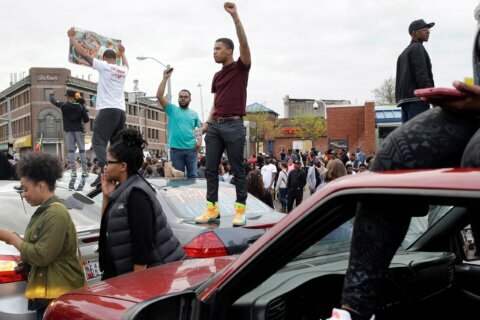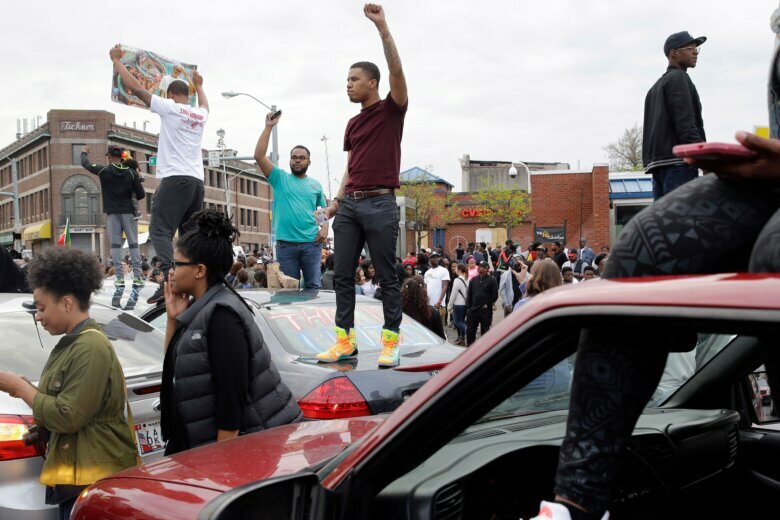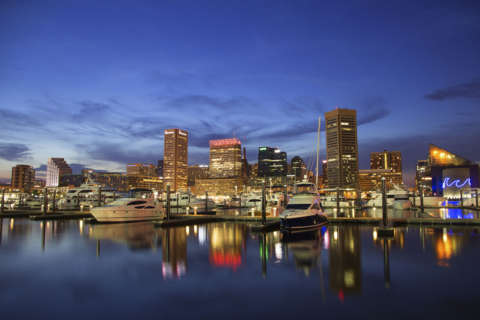
Nearly five years ago, the prosecution of six Baltimore police officers in the case of Freddie Gray, a 25-year-old Black man whose death in police custody sparked historic unrest in the city, ended with no convictions.
After three officers in the case were each tried and acquitted, Baltimore State’s Attorney Marilyn Mosby went to West Baltimore — where Gray was raised and arrested — to announce tihat she would be dropping charges against the remaining officers. Mosby said she “must consider the dismal likelihood” of conviction, describing the decision as “agonizing.”
Despite the failed prosecution, the criminal case against the officers proved a watershed moment. The Freddie Gray case instigated a new push for stronger police accountability laws and set the precedent in Baltimore and in cities across the country for implementing significant police reform.
“That accountability ultimately led to reform, and because of that reform, we had a spotlight on the entrenched police corruption in one of the largest police agencies in the country,” Mosby told CNN.
As a result of the case, officers are now mandated to seatbelt those in custody, call a medic when it’s requested, and intervene when fellow officers cross the line, Mosby said. Additionally, all police vans must be equipped with cameras.
Department underwent a ‘total makeover’
In the wake of Gray’s death, then-Mayor Stephanie Rawlings-Blake asked the Department of Justice to order a civil rights investigation into the city’s police department. The findings revealed a “pattern-or-practice of constitutional violations,” including excessive force and racially biased arrests. The probe ultimately led to the implementation of a federal consent decree in 2017 mandating systemic reform.
Baltimore has since undergone a “total makeover” of its police department after rewriting new policies, according to Baltimore Police Commissioner Michael Harrison, who also serves as the president of the board for the Police Executive Research Forum (PERF), a national police research and policy organization that advises police leaders on best practices.
Baltimore now has “probably the most robust” use-of-force policy in the country, which emphasizes the “sanctity of life” and de-escalation strategies, Harrison told CNN. The department has also revised policies on stops, searches and arrests, fair and impartial policing, youth engagement, peer intervention, responding to lesser offenses, and behavioral health awareness and crisis intervention.
In 2016, Baltimore was already ahead of many other big city police agencies in assigning body-worn cameras to every sworn member of the department. Officers are using less force and are receiving fewer complaints, a sign that the city is “turning the corner,” Harrison said, but the department still has a “long way to go” in becoming more responsive and respectful to the community.
Despite the significant reforms being implemented, many residents in neighborhoods that are most affected by the city’s ongoing violence have yet to see the cultural changes within the department or experience a more trusting relationship with police, according to Ray Kelly, a lifelong resident and community advocate of West Baltimore. Kelly is also the lead community liaison for the Independent Monitoring Team, which was appointed by a federal judge to help oversee the implementation of the consent decree.
A national reckoning over policing, however, has prompted many agencies to regard Baltimore as a model, looking at its reform policies as they revise their own, Commissioner Harrison said. This comes as the Justice Department has begun ramping up efforts to hold police accountable for misconduct and constitutional violations.
Attorney General Merrick Garland has launched two separate federal civil probes into departments in Minneapolis, where George Floyd was killed by then-officer Derek Chauvin, and in Louisville, where Breonna Taylor was fatally shot by officers in her apartment during a botched raid. Garland said the investigations would determine whether the agencies have a “pattern or practice of unconstitutional or unlawful policing.”
After a Minneapolis jury found Chauvin guilty on murder and manslaughter charges in Floyd’s death, Commissioner Harrison pledged to “reeducate our officers about our policies and double down on both our policies and training.”
Even as Baltimore approaches the fifth year of its consent decree, the department is not in compliance with “any component” of the mandated reforms, nor have there been any significant changes at the street level, said Ray Kelly.
Consent decree about ‘constitutional policing’
US District Judge James Bredar will determine when the city is in full compliance, but it could take years before residents see and feel a difference in how police engage with communities, Kelly said.
“We don’t know how long it’s going to take to undo the embedded corruption and racism in the Baltimore Police Department,” Kelly said.
The most recent report by the Independent Monitoring Team indicated that the city is on the right track. The report says that Baltimore’s compliance with the consent decree is “no longer merely aspirational, it is plausible,” with foundational reforms in “policies, training and operations in place.”
“Reform is now moving off the drawing board and into practice and performance,” the report says. The agency’s training academy has been leading a rigorous program of in-person and virtual courses on revised policies that the monitoring team praised as its “greatest accomplishment so far.”
The department has designed and completed training on new policies such as stops, searches, and arrests, behavioral health awareness, peer intervention and misconduct investigations.
But reform efforts are routinely eclipsed by the high level of violence that continues to plague Baltimore’s underserved communities, claiming a disproportionate number of Black lives, and perpetuating a cycle of grief and trauma. The city had its second-deadliest year on record in 2019 with 348 homicides. Baltimore recorded 335 homicides in 2020 and is headed on the same path with 167 homicides halfway into this year.
“We have the blueprint the country wants for police reform, but police reform is in no way the definition of public safety,” said Ray Kelly. “If you’re investing in the root causes of crime and violence, you diminish the need for so much aggressive policing in communities. This consent decree is not about public safety, it’s about constitutional policing.”
Commissioner Harrison echoed the same sentiment, arguing that government leaders must address issues such as poverty, lack of education and opportunities, and substandard housing that either “pull or push people into a life of crime for survival.”
Baltimore Mayor Brandon Scott was among several state and local leaders who last week met with President Joe Biden at the White House to discuss the nationwide surge in violent crime. Biden unveiled a comprehensive crime-fighting strategy after the meeting, emphasizing the need for stricter gun laws. Over 80% of guns in Baltimore are coming from outside of the city and 63% come from out of state, according to the mayor.
“What was the most beneficial and caused the most hope for me is having a president that understands we have to start investing in community-based leaders who run a violence intervention and prevention program,” Mayor Scott told CNN.
Gray’s death set precedent for accountability
On April 12, 2015, Freddie Gray encountered police officers in a high-crime area that was notorious for drug dealing. Gray, after making eye contact with police, ran. The officers arrested him on a weapons charge after finding a knife in his pocket, according to prosecutors.
Gray was put into the back of a police van without cameras, “handcuffed, shackled by his feet and unrestrained.” He was found unresponsive 40 minutes later upon arriving at the police station, prosecutors said. After slipping into a coma, Gray died one week later from a spinal cord injury. The medical examiner’s office ruled his death a homicide.
On the day of his funeral, the city broke out in widespread protests that gave way to violence and looting, prompting Gov. Larry Hogan to call in the National Guard and declare a state of emergency. A week into the protests, State’s Attorney Mosby announced charges against the six officers involved in his arrest.
Baltimore recorded 342 homicides that year, a 62% increase over 2014. More than 90% of the victims were Black men. Community-police relations were further strained in 2017 when authorities indicted eight members of an elite plainclothes unit known as the Gun Trace Task Force who were accused of extensive corruption — planting evidence, taking drug dealers’ money and selling seized drugs for their personal profit.
After the case in Gray’s death was closed, then-mayor Rawlings-Blake criticized Mosby for announcing charges too quickly and “bowing to political pressure.” Prosecutors had to rely on “circumstantial evidence” because the van was not equipped with cameras to determine when and how Gray was injured, Mosby told CNN.
Many criminal justice advocates were not surprised by the outcome, while others felt like one of their biggest champions gave up on the fight, Kelly said.
But Mosby’s decision to prosecute the officers “set the precedent to actually indict and arrest officers for their wrongdoing,” Kelly said. “Just creating that conversation that made people feel empowered enough to pursue police accountability was a big deal.”
Even though the officers in the Gray case were not convicted, “every single police officer is now being held accountable for the actions of a few,” Mosby said. Mosby’s office has prosecuted 34 officers since Gray’s death, 27 of whom have been convicted, she said.
This year, Mosby announced she would not prosecute drug possession and other low-level offenses, asserting there is “no public safety value.” For Black Americans, Mosby said, “These offenses can lead to a death sentence.”
Baltimore has had five police commissioners since 2015, including Darryl De Sousa in 2018, who was convicted on federal tax evasion charges and sentenced to 10 months in prison. In 2019, Commissioner Harrison was selected to head the agency given his well-regarded experience leading the New Orleans police department under a consent decree.
“Every agency has an organizational culture and behavior that grows and is cultivated because things are not addressed in the appropriate way,” Harrison said. “I’m here to help create the culture that builds a department that people pay for, deserve and respect.”
During Harrison’s four-year term as New Orleans’ police chief, the department’s relationship with the community and approval rating improved, and the city’s homicide rate was the lowest in decades, according to the city’s former mayor Mitch Landrieu, who selected Harrison for the job in 2014.
“He was the perfect fit to take what was a very difficult task of getting police officers to conform to a new way of doing things and he had enough stature in the community where he was able to bridge that gap,” Landrieu told CNN. “And he was spectacular.”
As chief, Harrison said he “embraced and accepted” New Orleans’ consent decree, which brought him credibility with the community and led to more progress in the department each year.
“We were able to build relationships and we were able to show the community that we can self-police ourselves and provide policing services that are fair and equitable across the city,” he said.
Progress is not resonating with some
Baltimore’s community policing plan, which was approved by the Independent Monitoring Team last year after extensive public feedback, focuses on improving community relations and partnering with leaders to reduce crime. Residents have the chance to work with police to address their needs and build relationships, Commissioner Harrison said.
But the city’s police force faces significant challenges ahead in building trust with the communities it serves and sharing information about reforms being implemented under the consent decree. The progress in changing the department’s culture and practices is not resonating among residents of neighborhoods most affected by violent crime, according to Kelly.
Alex Long, a Baltimore resident and violence interrupter at Safe Streets, a public health program aimed at reducing gun violence among youth, said members of the community still don’t feel the police are there to keep them safe.
“There wouldn’t be such an outcry for help from the communities if there was so much change,” Long said. “Last month, I had to wrestle a young man down because he tried to shoot someone in the head. There were four officers standing on the corner who walked in the opposite direction.”
Commissioner Harrison said the incident was not brought to his attention. “We’re still changing the culture in the police department to a professional culture where officers respond appropriately, and they can get past their fears or perceptions about what they think will happen to them if they make a mistake,” he said.
Similarly, former two-term mayor and Maryland governor Martin O’Malley, who as mayor initiated the now much-criticized “zero tolerance policy” for violent offenders, is more critical of the touted progress.
“The implementation of body cameras and the updating of use-of-force policies are positive things, but there are many steps the police department has to take but hasn’t,” he said. O’Malley noted that Baltimore is one of the cities that leads the nation in the number of young Black men who meet violent deaths on its streets.
Earlier this year, Harrison promoted Col. Sheree Briscoe, who is Black, to be deputy commissioner, making her the highest-ranking woman in the department. Briscoe, who is charged with overseeing the day-to-day operations, has been with the department for 26 years.
After the 2015 protests, Briscoe realized the police department couldn’t make fundamental changes on its own. Building relationships with communities, other law enforcement agencies, government leaders, and organizations is critical to help “uplift the strategies that we are working on now,” she said.
Violence as a ‘public health issue’
Baltimore was one of three of the largest police jurisdictions in the country — including Raleigh, North Carolina, and Baltimore County — that did not report an increase in any category of violent crime last year, which includes homicide, rape, robbery, and aggravated assault, according to a report produced by the Major Cities Chiefs Association.
The city experienced mostly peaceful demonstrations last summer after Floyd was killed, with officers exhibiting a level of restraint and solidarity with protesters. Commissioner Harrison said he was able to keep a strong police presence in communities to combat crime, while other cities shifted resources to respond to moments of unrest and looting.
Chuck Wexler, executive director of the Police Executive Research Forum, credited the city’s ability to keep crime under control last year to the “lessons learned” from the Freddie Gray case.
Earlier this month, the Baltimore City Council approved a $28 million increase in department spending, proposed by Mayor Scott, for the upcoming year. The funds will cover employee pension and health care costs after slashing $22 million from the police budget last year amid calls to defund the police.
Community advocates have criticized the budget increase and have raised concerns over consent decree funding, arguing the money could be better spent on youth programs, affordable housing, and mental health services.
Mayor Scott, a Baltimore native who previously served as president of the City Council, assumed office in December 2020, after campaigning on a platform to defund the police. “We are in a unique place under a consent decree that we asked for and have to fund. We fought for police reform,” Scott told CNN.
Scott said he has long advocated for a “reimagining of public safety.”
“We cannot continue to say to the police that they have to do everything,” Scott said. “They’re not mental health clinicians. They’re not substance abuse workers. They’re not child case managers. We have to rethink how we do the system in its entirety.”
Like cities across the country, Baltimore launched a pilot program this month to divert some 911 calls to social workers and clinicians. The 911 Diversion Pilot will tend to individuals experiencing mental health issues but who do not pose a danger to others.
Scott established the Mayor’s Office of Neighborhood Safety and Engagement shortly after taking office to look at violence as a “public health issue” and approach public safety through a “holistic” lens of trauma, equity and healing. The office partners with community and city-based leaders to address the root causes of violence to reduce crime.
Maryland Gov. Larry Hogan has been critical of Baltimore’s leadership in combating violent crime, saying the city needs to do “a better job.” But a recent meeting with Mayor Scott, Commissioner Harrison, and Hogan on violent crime in Baltimore proved to be “very productive,” according to Scott. They discussed the need for collaboration with state law enforcement agencies to address public safety.
While Baltimore is “ahead of the game” in revamping the culture and practices of the police department, said Mayor Scott, “this is not time to celebrate for me. This is time to dig our heels in and do the even tougher work of continuing our reimagining of public safety.”
Meaningful change could take years
Over the next few months, the police department will continue to train officers on revised policies and document police encounters with the community using a new Records Management System (RMS) to track investigative stops, arrests and investigations.
Every officer on the force has been trained in peer intervention to step in when fellow officers cross the line, a program called Ethical Policing is Courageous (EPIC). Just last month, the police department launched a new initiative called the Strategic Framework for Advancing Equity to solidify “a department-wide understanding of equity and inclusion principles” by addressing racial disparities in policing.
It’s a balancing act, said Harrison, in making sure officers are trained on revised policies to meet deadlines required by the consent decree while at the same time keeping a strong police presence on the streets to combat crime.
The agency, however, is already falling short in reaching staffing levels required by the consent decree with 2,398 sworn officers, 387 less than what’s needed, according to a recent independent monitor report. Nationally, departments have been struggling with recruitment and retention as they face an anti-police climate. But in 2020, Baltimore still saw the largest number of hires in 12 years, Deputy Commissioner Briscoe said.
The department has been steering its recruitment efforts toward women and minority residents to better reflect the communities it serves, Briscoe said. As of June, racial and ethnic minority groups make up almost 60% of the department’s workforce and women account for roughly 15%. Around 40% of the city’s officers are Black, according to agency data.
Since 2015, the agency has implemented an examination in the screening process of applicants that includes a psychological assessment, a comprehensive background investigation, and a social sensitivity and cultural competency test.
“A major challenge is getting officers to change the way they think about how we deliver policing services and help them stay proactive and positive,” said Commissioner Harrison.
Under federal oversight, the department is required to conduct assessments and audits of its performance and arrests. This includes tracking when officers act out of policy and detailing how they were disciplined and retrained following the incident, according to Harrison.
Baltimore is now entering the “hard part” of the reform process, according to the latest Independent Monitor Report, by demonstrating that the reforms are “translating into constitutional, accountable, community-oriented policing.”
At this stage, there are “plenty of things we can read, but nothing we can see yet,” Kelly said. Communities in Baltimore and nationally have been “demanding change for so long,” he said, but they are realizing that meaningful change could take years.








